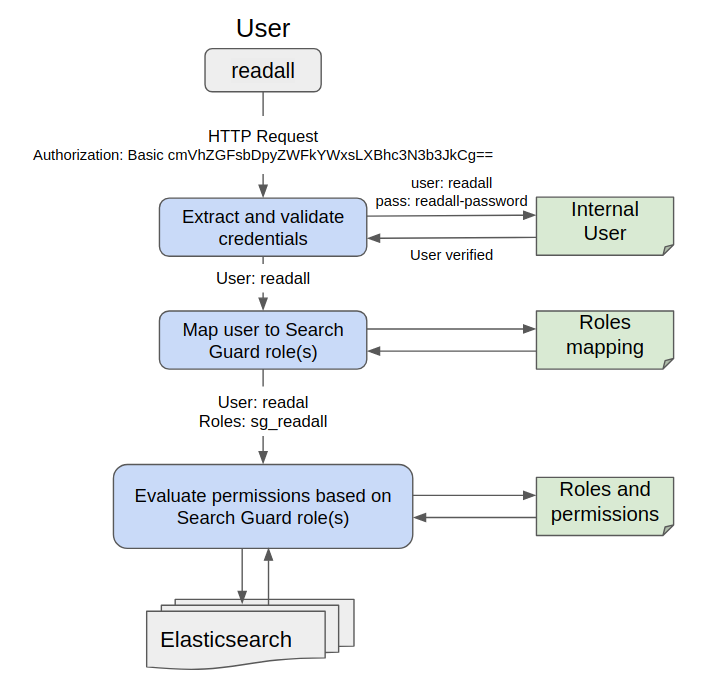You are looking at the documentation of a prior release. To read the documentation of the latest release, please
visit here.
New to KubeDB? Please start here.
Search Guard Configuration
Search Guard configuration enables basic flow as follows:
- Search Guard authenticates the credentials against the configured authentication backend(s).
- Search Guard authorizes the user by retrieving a list of the user’s roles from the configured authorization backend
- Roles retrieved from authorization backends are called backend roles.
- Search Guard maps the user and backend roles to Search Guard roles.
- Search Guard determines the permissions associated with the Search Guard role and decides whether the action the user wants to perform is allowed or not.
Before You Begin
At first, you need to have a Kubernetes cluster, and the kubectl command-line tool must be configured to communicate with your cluster. If you do not already have a cluster, you can create one by using Minikube.
Now, install KubeDB cli on your workstation and KubeDB operator in your cluster following the steps here.
To keep things isolated, this tutorial uses a separate namespace called demo throughout this tutorial.
$ kubectl create ns demo
namespace "demo" created
$ kubectl get ns demo
NAME STATUS AGE
demo Active 5s
We will use htpasswd** to hash user password. Install apache2-utils package for this.
$ sudo apt-get install apache2-utils
To keep configuration files separated, open a new terminal and create a directory /tmp/kubedb/sg
mkdir -p /tmp/kubedb/sg
cd /tmp/kubedb/sg
Note: Yaml files used in this tutorial are stored in docs/examples/elasticsearch folder in github repository kubedb/cli.
Create Configuration
The configuration consists of the following files.
sg_config.ymlconfigure authenticators and authorisation backends.sg_internal_users.ymlstores users, roles and hashed passwords in the internal user database.sg_action_groups.ymldefine named permission groups.sg_roles.ymldefine roles and the associated permissions.sg_roles_mapping.ymlmap backend roles, hosts and users to roles.
If you do not provide Secret for configuration, KubeDB will create one with default setup.
sg_config.yml
The main configuration file for authentication and authorization modules is sg_config.yml. It defines how Search Guard retrieves the user credentials,
how it verifies these credentials, and how additional user roles are fetched from backend systems.
It has two main parts:
searchguard:
dynamic:
authc:
...
authz:
...
See details about authentication and authorisation in Search Guard documentation.
We will use following config data in this tutorial
searchguard:
dynamic:
authc:
basic_internal_auth_domain:
enabled: true
order: 4
http_authenticator:
type: basic
challenge: true
authentication_backend:
type: intern
$ wget https://raw.githubusercontent.com/kubedb/cli/0.8.0/docs/examples/elasticsearch/search-guard/sg-config/sg_config.yml
sg_internal_users.yml
Internal users are configured in sg_internal_users.yml.
Syntax:
<username>:
hash: <hashed password>
roles:
- <rolename>
- <rolename>
See details about internal users in Search Guard documentation.
KubeDB needs user admin and readall for backup and restore process.
Create two hashed password for user admin and readall
export ADMIN_PASSWORD=admin-password
export READALL_PASSWORD=readall-password
export ADMIN_PASSWORD_HASHED=$(htpasswd -bnBC 12 "" $ADMIN_PASSWORD | tr -d ':\n' | sed 's/$2y/$2a/')
export READALL_PASSWORD_HASHED=$(htpasswd -bnBC 12 "" $READALL_PASSWORD | tr -d ':\n' | sed 's/$2y/$2a/')
Here,
adminuser password :admin-passwordreadalluser password :readall-password
This following template file is used to substitute password for internal user.
admin:
hash: $ADMIN_PASSWORD_HASHED
readall:
hash: $READALL_PASSWORD_HASHED
Run following command to write user information in sg_internal_users.yml file with password.
curl https://raw.githubusercontent.com/kubedb/cli/0.8.0/docs/examples/elasticsearch/search-guard/sg-config/sg_internal_users.yml | envsubst > sg_internal_users.yml
Note: Random password is set if KubeDB creates Secret for Users.
sg_action_groups.yml
An action group is simply a collection of permissions with a telling name. Action groups are defined in the file sg_action_groups.yml
and can be referred to in sg_roles.yml.
The file structure is very simple:
<action group name>:
- '<permission or action groups>'
- '<permission or action group>'
- ...
See details about action groups in Search Guard documentation.
Run following command to get action groups we will use in this tutorial
$ wget https://raw.githubusercontent.com/kubedb/cli/0.8.0/docs/examples/elasticsearch/search-guard/sg-config/sg_action_groups.yml
UNLIMITED:
- "*"
READ:
- "indices:data/read*"
- "indices:admin/mappings/fields/get*"
CLUSTER_COMPOSITE_OPS_RO:
- "indices:data/read/mget"
- "indices:data/read/msearch"
- "indices:data/read/mtv"
- "indices:data/read/coordinate-msearch*"
- "indices:admin/aliases/exists*"
- "indices:admin/aliases/get*"
CLUSTER_KUBEDB_SNAPSHOT:
- "indices:data/read/scroll*"
INDICES_KUBEDB_SNAPSHOT:
- "indices:admin/get"
sg_roles.yml
Search Guard roles and their associated permissions are defined in the file sg_roles.yml.
The syntax to define a role, and associate permissions with it, is as follows:
<sg_role_name>:
cluster:
- '<action group or single permission>'
- ...
indices:
'<indexname or alias>':
'<document type>':
- '<action group or single permission>'
- ...
'<document type>':
- '<action group or single permission>'
- ...
_dls_: '<Document level security query>'
_fls_:
- '<field level security fiels>'
- ...
tenants:
<tenantname>: <RW|RO>
<tenantname>: <RW|RO>
See details about roles and permissions in Search Guard documentation.
We will use following roles for Search Guard users.
sg_all_access:
cluster:
- UNLIMITED
indices:
'*':
'*':
- UNLIMITED
tenants:
adm_tenant: RW
test_tenant_ro: RW
sg_readall:
cluster:
- CLUSTER_COMPOSITE_OPS_RO
- CLUSTER_KUBEDB_SNAPSHOT
indices:
'*':
'*':
- READ
- INDICES_KUBEDB_SNAPSHOT
$ wget https://raw.githubusercontent.com/kubedb/cli/0.8.0/docs/examples/elasticsearch/search-guard/sg-config/sg_roles.yml
sg_roles_mapping.yml
Backend roles are roles that Search Guard retrieves during the authentication and authorization process. These roles are then mapped to the roles Search Guard uses to define which permissions a given user or host possesses.
In configuration, KubeDB sets for Search Guard, backend roles comes from:
- Roles defined in sg_internal_users.yml for particular users
- A JSON web token, if you’re using JWT authentication
- HTTP headers, if you’re using Proxy authentication
Mapping
Backend users, roles and hosts are mapped to Search Guard roles in the file sg_roles_mapping.yml.
Syntax:
<Search Guard role name>:
users:
- <username>
- ...
backendroles:
- <rolename>
- ...
hosts:
- <hostname>
- ...
See details about backend roles mapping in Search Guard documentation.
Get roles mapping by running
$ wget https://raw.githubusercontent.com/kubedb/cli/0.8.0/docs/examples/elasticsearch/search-guard/sg-config/sg_roles_mapping.yml
sg_all_access:
users:
- admin
sg_readall:
users:
- readall
Flow Diagram for User readall

Create Secret
Now create a Secret with these files to use in your Elasticsearch object.
$ kubectl create secret -n demo generic config-elasticsearch-auth \
--from-file=sg_config.yml \
--from-file=sg_internal_users.yml \
--from-file=sg_action_groups.yml \
--from-file=sg_roles.yml \
--from-file=sg_roles_mapping.yml \
--from-literal=ADMIN_PASSWORD=$ADMIN_PASSWORD \
--from-literal=READALL_PASSWORD=$READALL_PASSWORD
secret "config-elasticsearch-auth" created
Here,
- ADMIN_PASSWORD password is used for restoration process. See this
- READALL_PASSWORD password is used for backup process. See this.
If you do not use these two features of Snapshot, you can ignore adding this
--from-literal=ADMIN_PASSWORD=$ADMIN_PASSWORD
--from-literal=READALL_PASSWORD=$READALL_PASSWORD
Use this Secret config-elasticsearch-auth in your Elasticsearch object.
Create a Elasticsearch database
Below is the Elasticsearch object created in this tutorial.
apiVersion: kubedb.com/v1alpha1
kind: Elasticsearch
metadata:
name: config-elasticsearch
namespace: demo
spec:
version: "5.6"
databaseSecret:
secretName: config-elasticsearch-auth
storage:
storageClassName: "standard"
accessModes:
- ReadWriteOnce
resources:
requests:
storage: 50Mi
Here,
spec.databaseSecretspecifies Secret with Search Guard configuration and basic auth for internal user.
Create example above with following command
$ kubedb create -f https://raw.githubusercontent.com/kubedb/cli/0.8.0/docs/examples/elasticsearch/search-guard/config-elasticsearch.yaml
elasticsearch "config-elasticsearch" created
KubeDB operator sets the status.phase to Running once the database is successfully created.
$ kubedb get es -n demo config-elasticsearch -o wide
NAME VERSION STATUS AGE
config-elasticsearch 5.6 Running 57s
In this tutorial, we will expose ClusterIP Service config-elasticsearch to connect database from local.
$ kubectl expose svc -n demo config-elasticsearch --name=config-es-exposed --port=9200 --protocol=TCP --type=NodePort
service "config-es-exposed" exposed
$ kubectl get svc -n demo config-es-exposed
NAME TYPE CLUSTER-IP EXTERNAL-IP PORT(S) AGE
config-es-exposed NodePort 10.98.174.49 <none> 9200:31704/TCP 5s
Now, you can connect to this database using curl.
export es_service=$(minikube service config-es-exposed -n demo --url)
curl --user "admin:$ADMIN_PASSWORD" "$es_service/_cluster/health?pretty"
{
"cluster_name" : "config-elasticsearch",
"status" : "green",
"timed_out" : false,
"number_of_nodes" : 1,
"number_of_data_nodes" : 1,
"active_primary_shards" : 1,
"active_shards" : 1,
"relocating_shards" : 0,
"initializing_shards" : 0,
"unassigned_shards" : 0,
"delayed_unassigned_shards" : 0,
"number_of_pending_tasks" : 0,
"number_of_in_flight_fetch" : 0,
"task_max_waiting_in_queue_millis" : 0,
"active_shards_percent_as_number" : 100.0
}
Cleaning up
To cleanup the Kubernetes resources created by this tutorial, run:
$ kubectl patch -n demo es/config-elasticsearch -p '{"spec":{"doNotPause":false}}' --type="merge"
$ kubectl delete -n demo es/config-elasticsearch
$ kubectl patch -n demo drmn/config-elasticsearch -p '{"spec":{"wipeOut":true}}' --type="merge"
$ kubectl delete -n demo drmn/config-elasticsearch
$ kubectl delete ns demo
Next Steps
- Learn how to create TLS certificates.
- Learn how to use TLS certificates to connect Elasticsearch.
- Wondering what features are coming next? Please visit here.
- Want to hack on KubeDB? Check our contribution guidelines.



































